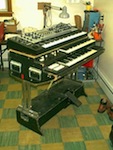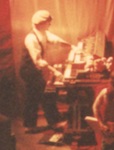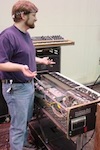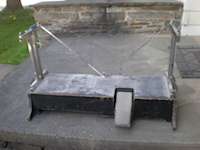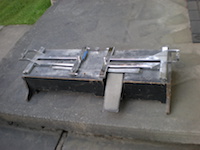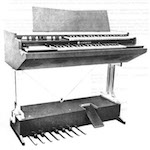Hammond Porta-B Tonewheel Spinet Organ
Last Update 06-29-2025
Since I was eighteen years old, I owned this Hammond Porta-B
organ. I had just started with my first club band and when I
told them my piano teacher was selling his Hammond organ with Leslie
760 they said "BUY IT!! BUY IT!!" Ow, twist my arm! It
was a good price and we were young with not much money. While
the Porta-B is not a "proper" Hammond like the B-3, my specimen is a
screaming organ. I played it for years and it is
currently in a state of disrepair, but in its heyday it was MUCH
easier to lug around than a 300 pound bulky Hammond B-3. I
decided even back in my teenage years that I was NOT going to ask my
bandmates to help move the large console organs, and that went for
the heavier Yamaha CP-70B electric grand piano (this was way before
digital pianos).
The impetus of the Hammond tonewheel organ takes its inspiration
from the Telharmonium, an electro-mechanical organ that played
"muzak" for turn of the 20th century telephone systems. It was
covered by a patent (US #580,035). The idea for revenue was a
subscription system for muzak service. Telephone technology
was in its infancy then, and the Telharmonium was not a success due
to customers complaining of faint music while carrying a phone
conversation - the strong organ signals were bleeding into the
telephone lines. Also this was before the vacuum tube triode
was invented and until then amplifiers did not exist, so the
Telharmonium had to use very large ferrous tonewheels and induction
coils to generate tones loud enough (from 12 to 15 thousand watts)
to be heard. The frigging thing was an electric power
generator. Due to these shortcomings in technology, the
Telharmonium consumed an enormous amount of space, weighed several
hundred tons, and required a dozen railroad freight cars to be
moved. While it was a failure, the pioneering technology
pointed the direction of miniature electronic organs.
Enter one Laurens Hammond, an inventor who built a successful
business selling electric
clocks that used the synchronous motor, which Laurens
invented. His clock could run from residental power in homes and
businesses - before that, clocks were mechanical and had to be wound
up periodically. He considered other applications for his
motor and was inspired by the Telharmonium as an organ product,
albeit much more compact. The synchronous motor rotates at the
frequency of the AC line voltage; thus as long as the 60hz line
frequency was constant from the utility company (50hz in most
foreign countries), the pitch of his electric organ would never go
out of tune. These innovative organs were first introduced in
1934 (in the middle of the Great Depression, which created badly
needed jobs), and Hammond continued making tonewheel organs until
1974 when technology had (long) surpassed the electro-mechanical
tone generation. No competitors ever copied the Hammond tone
generation method (it required a lot of expensive tooling and
Hammond kept many details a trade secret). For a few decades,
Hammond owned the electric organ market for worship, home, and
education.
This Porta-B model (and all tonewheel organ models) is from the electro-mechanical
Hammond organ family, whose tones are generated mechanically.
Inside the tone generator of
these organs are 91 rotating wheels about the size of an Eisenhower
dollar coin (remember those?), all driven from elaborate gearing
attached to a single synchronous motor. Each tonewheel is a ferrous
material which is notched along its outer edge; by rotating a
tonewheel next to a pickup with a coil of wire surrounding a
magnetic pole extended to the wheel, the notches produce an magnetic
field that oscillates which the pickup converts to an electric
signal, which is the musical tone. Repeat this 91 times by varying the number of
notches on the wheels, and all the pitches of the organ can be
comprised. From there the 91 tonewheel wires go to the
manuals, where they are distributed to key contacts (the contact
element was made of palladium, which doesn't tarnish and has a known
finite resistance per length) per the drawbar assignment
chart. Pressing a key mates the contacts to a number of
busses, which are routed to the drawbars where the performer can set
levels for the harmonics. It's an elaborate matrix system.
Finally the drawbar outputs are summed to a matching transformer
which changes the impedance to an optimal level for coupling to the
electronic preamps and processors.
Why isn't the Porta-B a "proper" Hammond organ? Well, the "proper"
Hammond that everybody in secular music played is the B-3 organ but
those damn things are bulky and weigh 300lbs.
The Porta-B weighs half that, is easier to cart around, and fits in
a pickup truck much easier (us starving musicians went from gig to
gig with three pickup trucks). The Porta-B is actually a
derivative of the L-100 model. The only thing in common with
the B-3 is the tonewheel generator (like the B-3 but unlike the
L-100, the Porta-B generator has all 91 tonewheels intact).
The manuals, the electronics, the vibrato/chorus, the percussion,
etc are all different from the B-3. The spinet class organs
(IE M-3, L-100) were designed to be less expensive and more
appealing to private homes than the bigger console organs
(B-3). The Porta-B vibrato/chorus is 100% electronic which is
nowhere near the sound of the B-3 mechanical scanner vibrato sound -
the B-3 vibrato/chorus has a pleasant "purr" that the cheaper spinet
organs lack. Might not be good enough for jazz, but that never
stopped me from exploiting the Porta-B.
Console organs had an inherent "key click" when a key contact was
closed on a buss. Worship and home organ owners complained of
this key click. Jazz and secular players embraced it.
But Hammond ignored the secular genres and key click was considered
a defect in the organ. Their solution was pre-emphasis,
a technique in which tonewheel generators were calibrated with
rising amplitudes as the tonewheel frequencies rose, then the high
frequencies were filtered to arise at the normal organ sound,
eliminating the key click in the process. When secular players
heard the new organs, they said "what happened to the
articulation?!?" You can't please everybody. The Porta-B
includes this pre-emphasis, so it doesn't have the key click that is
part of the rock music sound.
Another difference are the manuals. The console manuals have
"waterfall" keys, while spinet manuals have "diving board" keys
(referring to a cross section view of a key). This means that
certain techniques for waterfall keys - IE palm glissandos - don't
work with diving board keys. In fact in my early years of
playing the Porta-B I broke many keys (and shed some blood from my
hands in the process).
Jazz organ players are a snobbish lot (don't shoot me, I play jazz
too) who insist on B-3 (or C-3) organs and they wouldn't be caught
dead using a spinet L-100/Porta-B organ. Console organs had
manuals each with 61 keys, spinet organs had shorter manuals each
with 44 keys. Many rock bands playing clubs saw the spinet
organs as easier to gig, and the Porta-B had a novel method of
assembly and packing. The Porta-B is actually two cases.
The upper case contains the tone generators, upper/lower manuals,
drawbars, controls, and electronic modules (which are tube-based,
thankfully). The lower case contains the power amplifier,
reverb tank, swell (volume) pedal, pedal manuals, and a pair of
solid steel supports that the upper case is placed on. If you
intend to buy a Porta-B, MAKE SURE the cross brackets for the
supports are included as they serve to make the whole thing a rigid
assembly. The supports are hinged so that when the organ is
disassembled for carting the supports lay flat for minimal storage
space (see pictures above).
A multipin connector on one of the supports mates to one in the
upper case. When the upper case is placed on the supports,
there are holes that line up to pins on the supports, which also
mates the multipin connectors. That completes all the wiring
for an organ with the exception of the AC power line, on a separate
loose cord that plugs into the upper case. The upper case
weighs about 75lbs, the lower case weighs about 50lbs. In the
1970s, that was the smallest Hammond you could gig; compact
electronic organs (no tonewheels, no tubes) started appearing about
1975 but none of them sounded as good as a Hammond. After all,
I am a snob...
The original handles on the upper case were a weak point and I
replaced them long ago with better handles. A few years later
I removed the 13-note pedal manual because I never used them and
they were dead weight. Later I removed the dead weight
internal speakers as I had no use for them, but the drivers MUST be
replaced with a power resistor because the amplifier output cannot
be open circuit and it MUST have a load. After going through
my old music pictures I don't have a picture of the organ by
itself. The top of the organ was convenient to stack a
keyboard or two (see pictures above). I gigged the Porta-B
with a 150lb electronic piano on top, which ultimately damaged the
upper case.
I cut my teeth as a Hammond player using the Porta-B.
It was a screaming organ that really sounded great with a
rock band. When I did a hand glissando to the last upper
octave of the manual, you really hear it (esp that high C). I
also learned a lot of comping techniques using drawbars - I am a
drawbar artist on Hammonds. It worked well in classic rock,
and really well in an R&B/Funk/Blues band I played
in. I re-built the damaged upper case for the R&B band,
and a lot of people loved the sound. I'll compile some
examples from band recordings later.
The Porta-B began life as a prototype
L100P developed in Antwerp Belgium in the late 1960s.
The european market L100P has a different left hand panel from the
US and CN models. There were two versions of the
Porta-B. The early one had a CHORUS tab; later models replaced
the CHORUS tab with a Pedal to Lower Manual link function, which
layered the lower manual with the pedal manual an octave lower
(although only to low F). However it is very simple to route
an RCA cable inside the organ to (permanently) enable the CHORUS
function. Also the early models did not have a Leslie jack for
the 9-pin models.
In Canada the same model was known as the L100P but with the left
hand panel of the Porta-B.
The first decent "clonewheel" organ for gigging - a single manual
compact organ faithful to the Hammond sound - was the 1990 Hammond
XB-2. By then I also had my Dynacord CLS-222
Leslie simulator, so the two of them allowed me to leave the
heavy Porta-B and Leslie cabinet at home. By 2005 the Hammond XK-3
was introduced and I eagerly embraced it as it had a feature that
could duplicate the sound of my Porta-B. I could finally use
my favorite "comp" drawbar settings and the XK-3 sounded like my
Porta-B. The XK-3 was a very faithful reproduction of the B-3,
and the later XK-3c with XLK-3 lower manual was even better.
I last used the Porta-B in 2010 when it fell off the tailgate of my
pickup at the end of a gig, which broke the case again and this time
dislodged some of the internals. Due to time constraints I
haven't yet restore it. It is way down the priority list but I
look forward to getting it working again.

Home
